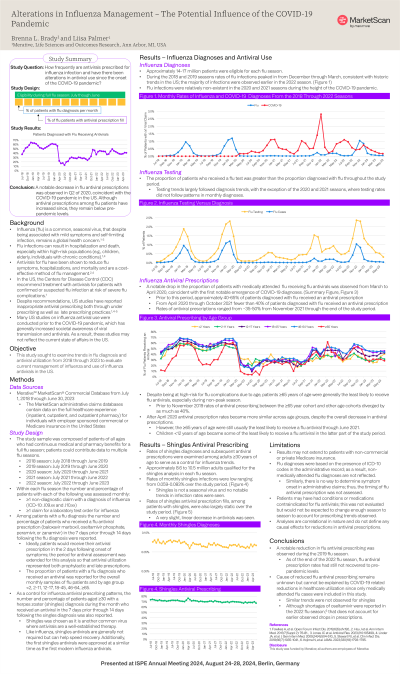COVID-19
Session: Poster Session A
(085) Alterations in Influenza Management - the Potential Influence of the COVID-19 Pandemic
Monday, August 26, 2024
8:00 AM - 6:00 PM CEST
Location: Convention Hall II


Brenna Brady, PhD
Practice Leader, Real Word Data Research & Analytics
Merative, United States- LP
Liisa Palmer
Merative, United States
Presenting Author(s)
Co-Author(s)
Background: Seasonal influenza (flu) infection is a common cause of winter colds and has historically been managed without pharmaceutical intervention. Vaccination remains the primary preventative measure; however, approval of modern flu antivirals in 1999 provided an option to help reduce the duration and severity of disease following infection.
Objectives: This study used the MarketScan Commercial and Medicare Databases to investigate trends in flu diagnosis and management since 2018.
Methods: Patients with continuous eligibility for a full flu season (July 1 through June 30) were identified in the MarketScan Commercial and Medicare databases for the 2018 through 2021 flu seasons. Within each flu season cohort, the number of patients with a flu diagnosis and test were assessed on a monthly basis; utilization of antivirals was examined among patients with a flu diagnosis.
Results: Between 13.8 and 17.2 million patients qualified for each flu season cohort. The pre-pandemic portions of the 2018 and 2019 seasons demonstrated similar, cyclic trends with flu testing and diagnoses peaking between December and March. At peak, ~2% of patients were tested for flu and ~1% had a flu diagnosis in a one-month period. The cyclic pattern disappeared in the 2020 and 2021 seasons, with low rates of testing and diagnoses. At peak, rates of testing (0.6%) and diagnosis (0.03%) in the 2020 season were less than half of the 2019 season; rates increased to ~1.5% and ~0.2% respectively in the 2021 season. Among patients diagnosed with flu, antiviral utilization sharply decreased with the emergence of COVID-19. Pre-pandemic 37-64% of flu patients received an antiviral. From February to March 2020 antiviral utilization fell from 56% to 22%. Antiviral use slowly increased after April 2020; however rates of use remained below those of the pre-pandemic era peaking at 48%. Trends were not driven by specific age groups. Over the study period, patients aged ≥65 tended to have the lowest antiviral use, while patients aged 12-64 had the highest. The exception was May-September 2020 where antiviral use in patients ≤11 years surpassed that of 12–64year olds.
Conclusions: This study identified a notable drop in flu antiviral use coincident with the COVID-19 pandemic that had not recovered to pre-pandemic levels by the mid-2022. Although reduced rates of infection and testing in the 2020 season are almost certainly linked to the pandemic, the reason for the reduction in antiviral use among infected patients remains unclear. Additional study into antiviral prescribing trends, potentially in relation to flu season severity or changing prescribing perceptions, are warranted to provide greater insight into flu management in the US.
Objectives: This study used the MarketScan Commercial and Medicare Databases to investigate trends in flu diagnosis and management since 2018.
Methods: Patients with continuous eligibility for a full flu season (July 1 through June 30) were identified in the MarketScan Commercial and Medicare databases for the 2018 through 2021 flu seasons. Within each flu season cohort, the number of patients with a flu diagnosis and test were assessed on a monthly basis; utilization of antivirals was examined among patients with a flu diagnosis.
Results: Between 13.8 and 17.2 million patients qualified for each flu season cohort. The pre-pandemic portions of the 2018 and 2019 seasons demonstrated similar, cyclic trends with flu testing and diagnoses peaking between December and March. At peak, ~2% of patients were tested for flu and ~1% had a flu diagnosis in a one-month period. The cyclic pattern disappeared in the 2020 and 2021 seasons, with low rates of testing and diagnoses. At peak, rates of testing (0.6%) and diagnosis (0.03%) in the 2020 season were less than half of the 2019 season; rates increased to ~1.5% and ~0.2% respectively in the 2021 season. Among patients diagnosed with flu, antiviral utilization sharply decreased with the emergence of COVID-19. Pre-pandemic 37-64% of flu patients received an antiviral. From February to March 2020 antiviral utilization fell from 56% to 22%. Antiviral use slowly increased after April 2020; however rates of use remained below those of the pre-pandemic era peaking at 48%. Trends were not driven by specific age groups. Over the study period, patients aged ≥65 tended to have the lowest antiviral use, while patients aged 12-64 had the highest. The exception was May-September 2020 where antiviral use in patients ≤11 years surpassed that of 12–64year olds.
Conclusions: This study identified a notable drop in flu antiviral use coincident with the COVID-19 pandemic that had not recovered to pre-pandemic levels by the mid-2022. Although reduced rates of infection and testing in the 2020 season are almost certainly linked to the pandemic, the reason for the reduction in antiviral use among infected patients remains unclear. Additional study into antiviral prescribing trends, potentially in relation to flu season severity or changing prescribing perceptions, are warranted to provide greater insight into flu management in the US.
